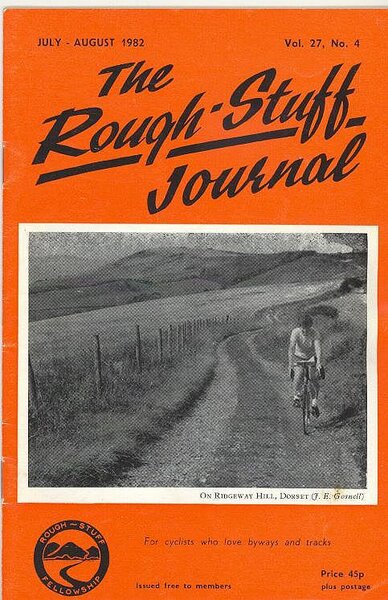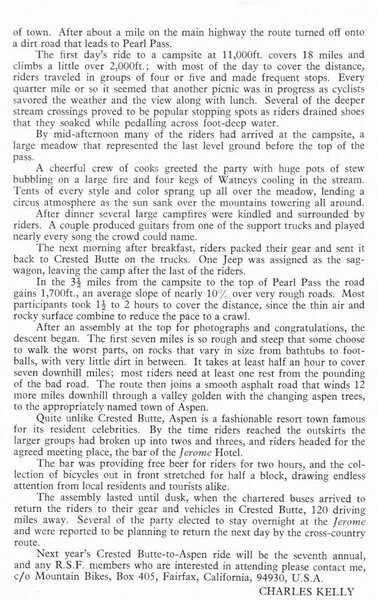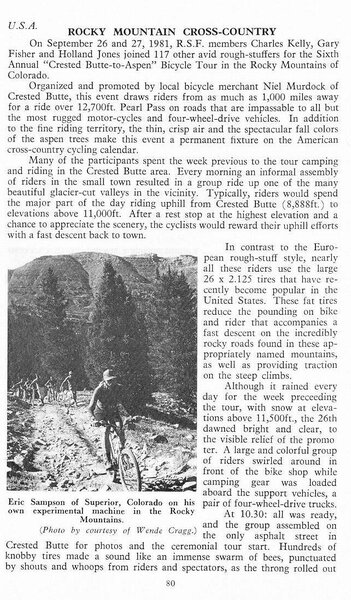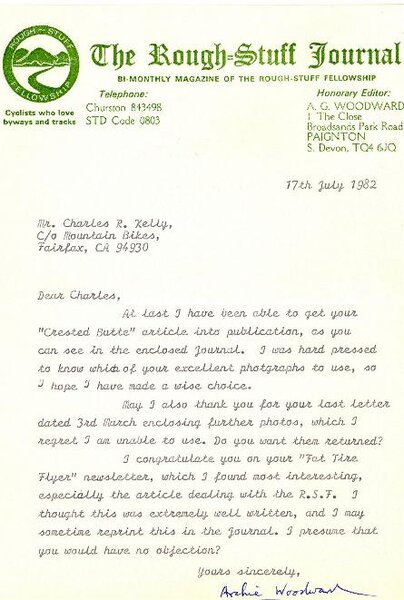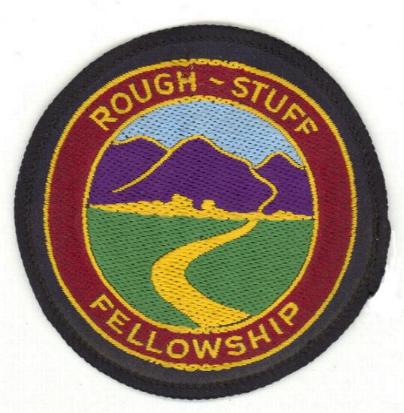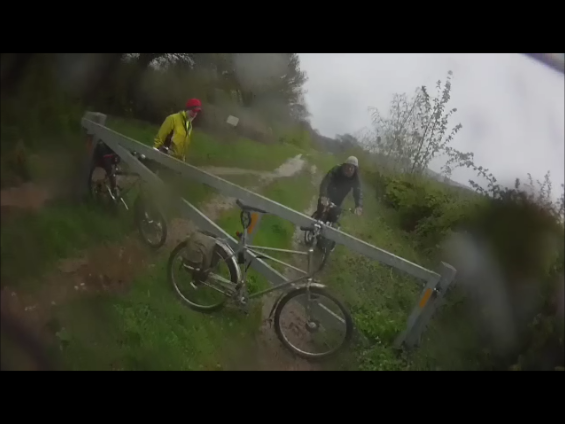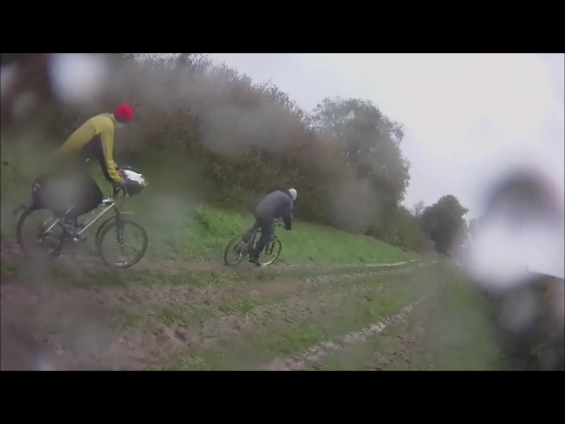You are using an out of date browser. It may not display this or other websites correctly.
You should upgrade or use an alternative browser.
You should upgrade or use an alternative browser.
Rough-Stuff Fellowship 1982
- Thread starter Repack Rider
- Start date
Repack Rider
Senior Retro Guru
Repack Rider
Senior Retro Guru
Great article. The 'Rough Stuff Fellowship' are still going strong > http://www.rsf.org.uk/
Would be interested to see the article on the RSF in the Fat Tire Flyer.
Would be interested to see the article on the RSF in the Fat Tire Flyer.
Repack Rider
Senior Retro Guru
RSF Letter
Here is more of my correspondence with the RSF.
Here is more of my correspondence with the RSF.
Repack Rider
Senior Retro Guru
wonderfull stuff!
read some old journals of theirs I found in the common room of a YHA (Youth Hostel) in the Yorkshire Dales.
A U.K. custom builder called Chas Roberts produces a lovely frame called the 'Rough Stuff' all fillet brazed etc. But the ethic is generally a bit more DiY than that...
read some old journals of theirs I found in the common room of a YHA (Youth Hostel) in the Yorkshire Dales.
A U.K. custom builder called Chas Roberts produces a lovely frame called the 'Rough Stuff' all fillet brazed etc. But the ethic is generally a bit more DiY than that...
- Feedback
- View
Geoff Apps writes about attitudes to cycling in the 1970s:
"The attitude amongst cyclists, and therefore the entire trade, all shops, magazines, clubs, everything cycling, was that riding off-road was, at best, a necessary evil. Even the RSF would wax lyrical about the experience of finding themselves somewhere remote, but if the ride experience was ever mentioned, it was to say how difficult or inconvenient it was."
"The idea of seeking out and delighting in riding rough terrain was utterly alien to all the cyclists I met and talked to. Rough Stuff Riders would get off and walk when I was able to keep riding.
I was invited to accompany the High Wycombe branch of the Rough Stuff Fellowship for a ride on Sunday the 29th of April 2012. Would they still get off and walk if the going got tricky. Or would the now common use of mountain bikes by RSF members changed their attitude to dismounting for the tricky bits?
Firstly the modern RSF are not put off by a little rain and despite forecasts for driving rain and gusty winds the ride went ahead. I went for the head to toe waterproof option whilst the RSF members used a diverse variety of wet weather gear the most effective of which was the traditional cyclists cape. With its well ventilated interior it suffered from non of the condensation issues that would make my own clothing damp despite the breathable fabrics. The first few miles of mostly road confirmed my fears that they might ride mostly on the road and then get off and walk the occasional bridleway. However they eventually turned off onto the rough stuff and cycled determinedly onwards and upwards through the rain. Mostly they rode mountain bikes complete with mudguards though a few rode touring bikes fitted with ordinary road tyres and hub gears. As the track became increasingly waterlogged and muddy I wondered how these traditional RSF riders would cope.
"The attitude amongst cyclists, and therefore the entire trade, all shops, magazines, clubs, everything cycling, was that riding off-road was, at best, a necessary evil. Even the RSF would wax lyrical about the experience of finding themselves somewhere remote, but if the ride experience was ever mentioned, it was to say how difficult or inconvenient it was."
"The idea of seeking out and delighting in riding rough terrain was utterly alien to all the cyclists I met and talked to. Rough Stuff Riders would get off and walk when I was able to keep riding.
I was invited to accompany the High Wycombe branch of the Rough Stuff Fellowship for a ride on Sunday the 29th of April 2012. Would they still get off and walk if the going got tricky. Or would the now common use of mountain bikes by RSF members changed their attitude to dismounting for the tricky bits?
Firstly the modern RSF are not put off by a little rain and despite forecasts for driving rain and gusty winds the ride went ahead. I went for the head to toe waterproof option whilst the RSF members used a diverse variety of wet weather gear the most effective of which was the traditional cyclists cape. With its well ventilated interior it suffered from non of the condensation issues that would make my own clothing damp despite the breathable fabrics. The first few miles of mostly road confirmed my fears that they might ride mostly on the road and then get off and walk the occasional bridleway. However they eventually turned off onto the rough stuff and cycled determinedly onwards and upwards through the rain. Mostly they rode mountain bikes complete with mudguards though a few rode touring bikes fitted with ordinary road tyres and hub gears. As the track became increasingly waterlogged and muddy I wondered how these traditional RSF riders would cope.
Attachments
- Feedback
- View
April 29th 2011 Rough Stuff Fellowship ride - PART TWO
...The trail was waterlogged. In some sections there were more puddles than mud. How deep the larger puddles were was unknown until someone rode through them. The deepest were over a foot deep and covered the entire trail. Often riding through the puddles was the easiest option as the mud was slippy and sometimes rutted. I was riding a Highpath Cleland which with its 2.4" low pressure tyres, massive wheel clearances and full mudguards is probably the best mud-bike ever made. But how did the road tyred, 4 speed hub geared touring bike cope? The answer is surprisingly well.
The mud was to wet to be sticky and the narrow tyres cut through to the drought hardened earth below. I would clear a tricky section with the help of my 15psi tyres only to be surprised as the road tyre clad bikes followed me through. The angular edges of their narrow tyres giving as much if not more lateral grip through the mud as my more rounded nobbly tyres. Whilst their almost slick tread cut through and gripped bellow when my wide soft tyres floated on top of the slime. I have no doubt that they would have got stuck if the mud had been deeper or the terrain more difficult but in the conditions of this ride they very coped well. The mountain bikes were generally faster but no one had to get off off and walk.
About 1pm we stopped to shelter under a bridge. Suddenly from nowhere appeared a twin burner camping stove with gas bottle, kettle, and fresh milk. These had apparently been hidden in the bushes in order to facilitate a tea break. I recommend this to Marin riders as a way of improving their Repack races. Having packed away we then rode through the rain for about an hour to a Pub. The rain then eased as we rode mostly downhill back towards Wycombe for about an hour. In total we had ridden 35 very wet but enjoyable miles. Throughout the ride people chatted whilst they cycled, more so than any other rides I have done as here there was no competition, just a common interest in cycling off the beaten track.
After tea and cakes and lots of chat, about 7pm a reduced group set out for an evening ride to a pub in Marlow and back in the dark. The combined mileage of the two rides was about 55 enjoyable miles.
The terrain ridden was far less technical than the riding I normally do and the hills on this ride were long and relatively gentle. However from the evidence of this one ride I would conclude that the use of mountain bikes has subtly changed the RSF when compared to the days when I and Geoff Apps rode with them in the 1980s. Getting off and walking is now less prevalent. And the RSF are more open to, "The idea of seeking out and delighting in riding rough terrain". Though not to the extent that Geoff Apps would constantly push the boundaries as to what can be ridden on a bicycle. And with little evidence of the thrill seeking antics of the modern trail centre riders.
The ethos of the RSF remains unchanged. That of enjoying the freedom of getting off-the beaten track on a bicycle. This is not as tame as it sounds as they will ride in weather conditions that many mountain bikers would not. And in a spirit of exploration, do not limit themselves to trails that can be ridden.
...The trail was waterlogged. In some sections there were more puddles than mud. How deep the larger puddles were was unknown until someone rode through them. The deepest were over a foot deep and covered the entire trail. Often riding through the puddles was the easiest option as the mud was slippy and sometimes rutted. I was riding a Highpath Cleland which with its 2.4" low pressure tyres, massive wheel clearances and full mudguards is probably the best mud-bike ever made. But how did the road tyred, 4 speed hub geared touring bike cope? The answer is surprisingly well.
The mud was to wet to be sticky and the narrow tyres cut through to the drought hardened earth below. I would clear a tricky section with the help of my 15psi tyres only to be surprised as the road tyre clad bikes followed me through. The angular edges of their narrow tyres giving as much if not more lateral grip through the mud as my more rounded nobbly tyres. Whilst their almost slick tread cut through and gripped bellow when my wide soft tyres floated on top of the slime. I have no doubt that they would have got stuck if the mud had been deeper or the terrain more difficult but in the conditions of this ride they very coped well. The mountain bikes were generally faster but no one had to get off off and walk.
About 1pm we stopped to shelter under a bridge. Suddenly from nowhere appeared a twin burner camping stove with gas bottle, kettle, and fresh milk. These had apparently been hidden in the bushes in order to facilitate a tea break. I recommend this to Marin riders as a way of improving their Repack races. Having packed away we then rode through the rain for about an hour to a Pub. The rain then eased as we rode mostly downhill back towards Wycombe for about an hour. In total we had ridden 35 very wet but enjoyable miles. Throughout the ride people chatted whilst they cycled, more so than any other rides I have done as here there was no competition, just a common interest in cycling off the beaten track.
After tea and cakes and lots of chat, about 7pm a reduced group set out for an evening ride to a pub in Marlow and back in the dark. The combined mileage of the two rides was about 55 enjoyable miles.
The terrain ridden was far less technical than the riding I normally do and the hills on this ride were long and relatively gentle. However from the evidence of this one ride I would conclude that the use of mountain bikes has subtly changed the RSF when compared to the days when I and Geoff Apps rode with them in the 1980s. Getting off and walking is now less prevalent. And the RSF are more open to, "The idea of seeking out and delighting in riding rough terrain". Though not to the extent that Geoff Apps would constantly push the boundaries as to what can be ridden on a bicycle. And with little evidence of the thrill seeking antics of the modern trail centre riders.
The ethos of the RSF remains unchanged. That of enjoying the freedom of getting off-the beaten track on a bicycle. This is not as tame as it sounds as they will ride in weather conditions that many mountain bikers would not. And in a spirit of exploration, do not limit themselves to trails that can be ridden.
Attachments
Similar threads
For Sale
Viking Head Badge & Ian Steel Decals
- Replies
- 0
- Views
- 150
- Replies
- 13
- Views
- 1K
- Replies
- 6
- Views
- 610
